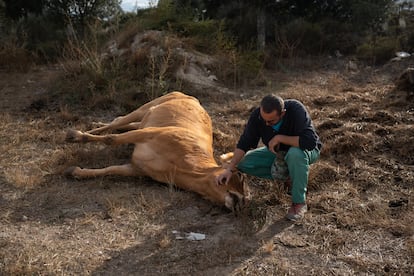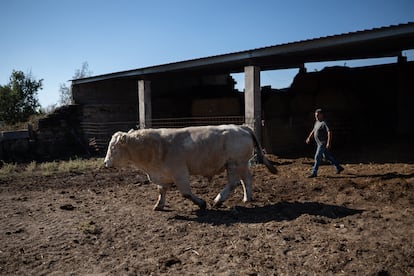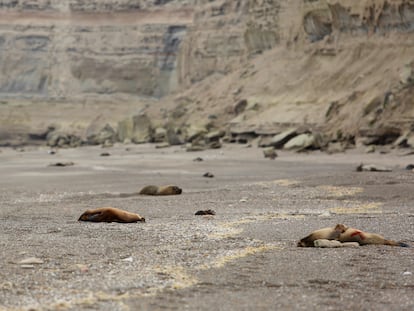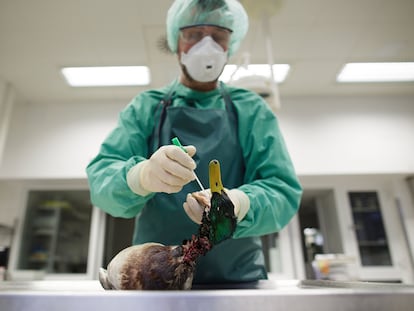‘Cow Covid’ threatens livestock ranches
Epizootic Hemorrhagic Disease (EHD) has killed hundreds of cattle in Europe after being detected in November 2022


The first case of Epizootic Hemorrhagic Disease (EHD) in Europe was detected in November 2022. Since then, it has become a threat to cattle ranchers like Marcelo Mozo in Zamora (northwest Spain). This virus spreads via an insect that is not common in Spain. However, climate change and international animal shipments have facilitated the spread of these disease vectors. EHD does not affect people or meat, but it poses a critical threat for livestock as there is no vaccine available — infected cattle must be slaughtered. Farmers and experts compare EHD to Covid-19 due to its multifaceted impact on ruminants and the difficulty of preventing contagion. Spain’s Ministry of Agriculture and Livestock and regional government officials issued warnings about this risk after dozens of outbreaks and animal deaths were reported. To prevent the spread of EHD, animals and vehicles must be disinfected before they can move from affected areas to EHD-free areas.
For the past three weeks, ranchers in Zamora have been dealing with a severe outbreak spreading north from southern Spain. Agricultural engineer and livestock rancher Fernando Vicente stressed the gravity of the situation, saying he watched tough ranchers break down in tears. “Animals are dying constantly — we’ve gone from collecting four carcasses a day to over thirty,” said Vicente, who hopes government officials will step up and send veterinarians to help. “It’s like Covid — it affects each animal differently. We’ve never seen anything like this.”
Vicente showed us a sick cow that had dropped over 300 pounds (150 kilos) since it was infected a week ago. It was covered in pustules, had sickly mucous membranes and a shriveled udder. “Look at her, with her head drooping. Her tongue is swollen, and she can’t graze,” said the frustrated rancher. “No politician of any stripe has come up with any solutions.” After being bitten by an infected insect, the cattle begin to show symptoms 5–10 days later. Sheep and goats have not been greatly impacted.
Jesús Ledesma can’t sleep, wondering whether he will wake up to find another dead cow in the morning. The 45-year-old cattle rancher near the tiny town of Muga de Sayago (northwest Spain) is deeply distressed about the spread of “cow Covid.” Ledesma has watched cattle with bloodshot eyes struggling to breathe, their mucous membranes infested with insect larvae. There is no official record-keeping of all the EHD-related deaths.
Contagion in southern Europe
The first case in Europe was detected in Italy last November and quickly spread to Spain, primarily in the southern regions. In recent weeks, cases have been detected further north in Castilla y León and Cantabria, although Spain’s Ministry of Health has only reported a few dozen cases. Currently, there are no authorized vaccines in Europe, so using insecticides and repellents on cattle, facilities, and vehicles is strongly recommended. EHD can spread during transportation of the cattle and events like agricultural fairs. However, these precautions may not always be effective due to the challenges associated with detecting the insect.

Salamanca hosted a livestock fair in early September as the problem continued to grow. Two weeks later, acting Agriculture Minister Luis Planas convened meetings with representatives of regional governments, agricultural organizations and the livestock industry to address disease monitoring and control. The data collected will be sent to the Central Veterinary Laboratory in Algete (Madrid) for analysis.
According to Dolors Vidal, a professor of microbiology at the University of Castilla-La Mancha, the virus is spread by culicoides, a biting midge that is not actually a mosquito. “The virus is common in the Americas and can spread through infected insects,” said Vidal. “Changes in climate can affect the distribution of contagion vectors. As the virus was present in North Africa, it’s not surprising that it spread to Spain, similar to the bluetongue virus, which affects ruminants, including sheep and goats.”
Vidal points to insect bites as the main source of contagion and expects cattle to acquire immunity after an initial wave of deadly impacts. “As with any new viral disease, the population tends to be susceptible at first and experiences more severe clinical symptoms until developing immunity. Like the coronavirus, for example. But there is no need for alarm — mortality rates are relatively low.” Fernando Vicente fears that by then it will be too late for him and many others who will lose their livelihoods. “This is my home, and this is the only way I know how to make a living. The cows, they’re like family to us.”
Spain’s Ministry of Agriculture and Livestock requires animals and vehicles to be disinfected when moving from affected to unaffected areas. They also assure that meat and milk from sick animals can still be consumed. Similar to the bluetongue virus, common EHD symptoms include respiratory problems, fever, and lameness. It can also cause abortions and fertility problems in cows. EHD does not affect humans or the quality of meat, but it does have financial implications for livestock ranchers due to the added cost of veterinary care, prevention measures and depleted herds. Vultures seem to be the only things benefitting from this disease, as they grow fat on an abundance of carrion and fetuses aborted by sick cows.
Sign up for our weekly newsletter to get more English-language news coverage from EL PAÍS USA Edition
Tu suscripción se está usando en otro dispositivo
¿Quieres añadir otro usuario a tu suscripción?
Si continúas leyendo en este dispositivo, no se podrá leer en el otro.
FlechaTu suscripción se está usando en otro dispositivo y solo puedes acceder a EL PAÍS desde un dispositivo a la vez.
Si quieres compartir tu cuenta, cambia tu suscripción a la modalidad Premium, así podrás añadir otro usuario. Cada uno accederá con su propia cuenta de email, lo que os permitirá personalizar vuestra experiencia en EL PAÍS.
¿Tienes una suscripción de empresa? Accede aquí para contratar más cuentas.
En el caso de no saber quién está usando tu cuenta, te recomendamos cambiar tu contraseña aquí.
Si decides continuar compartiendo tu cuenta, este mensaje se mostrará en tu dispositivo y en el de la otra persona que está usando tu cuenta de forma indefinida, afectando a tu experiencia de lectura. Puedes consultar aquí los términos y condiciones de la suscripción digital.
More information
Archived In
Últimas noticias
Most viewed
- Alain Aspect, Nobel laureate in physics: ‘Einstein was so smart that he would have had to recognize quantum entanglement’
- David King, chemist: ‘There are scientists studying how to cool the planet; nobody should stop these experiments from happening’
- Key points of the military attack on Venezuela: Early morning bombings and a ‘captured’ president
- Mexico completes its trade shift with the entry into force of tariffs on China and countries without trade agreements
- Maps of the US attack on Venezuela: Targets, airspace and deployed fleet










































